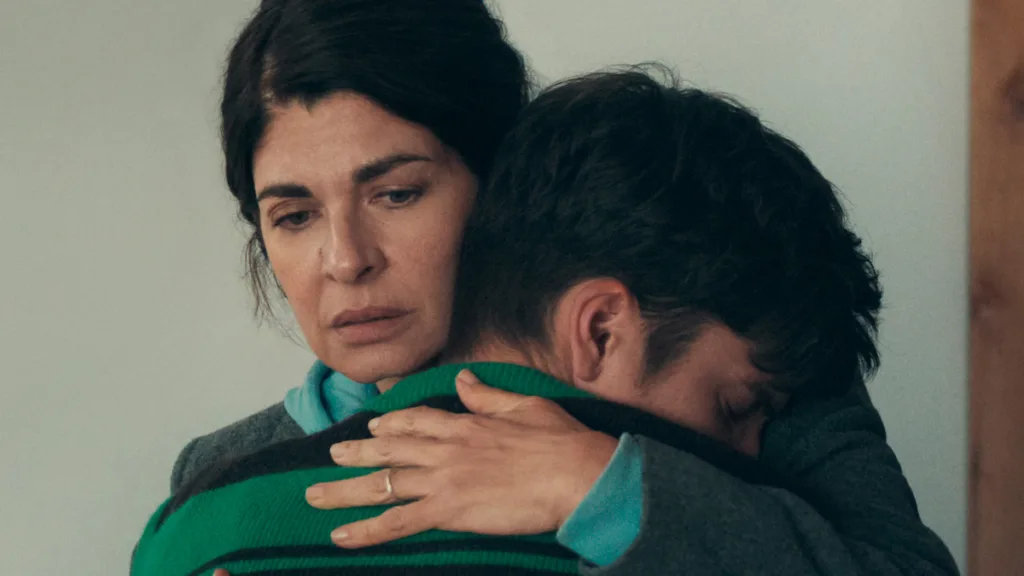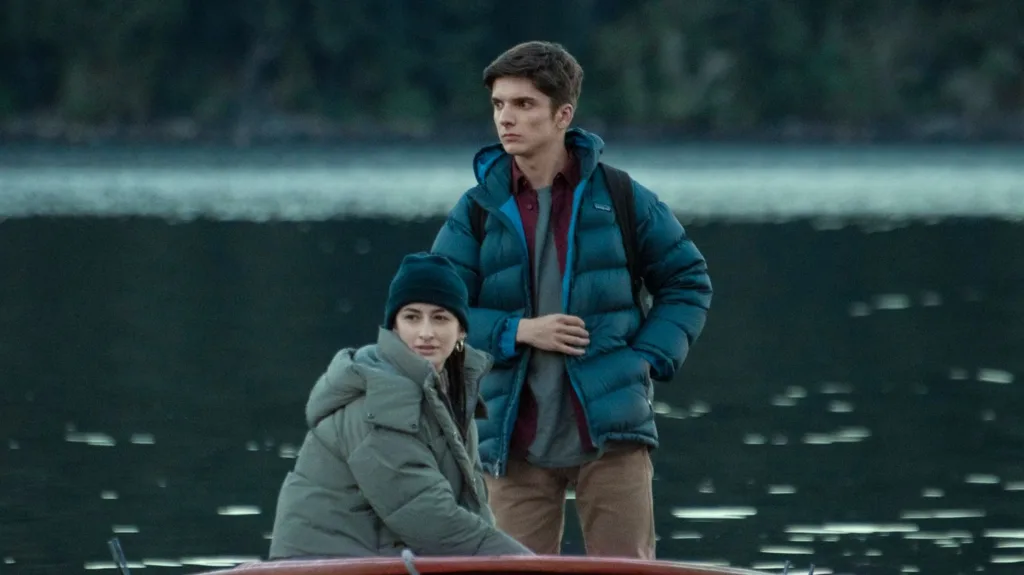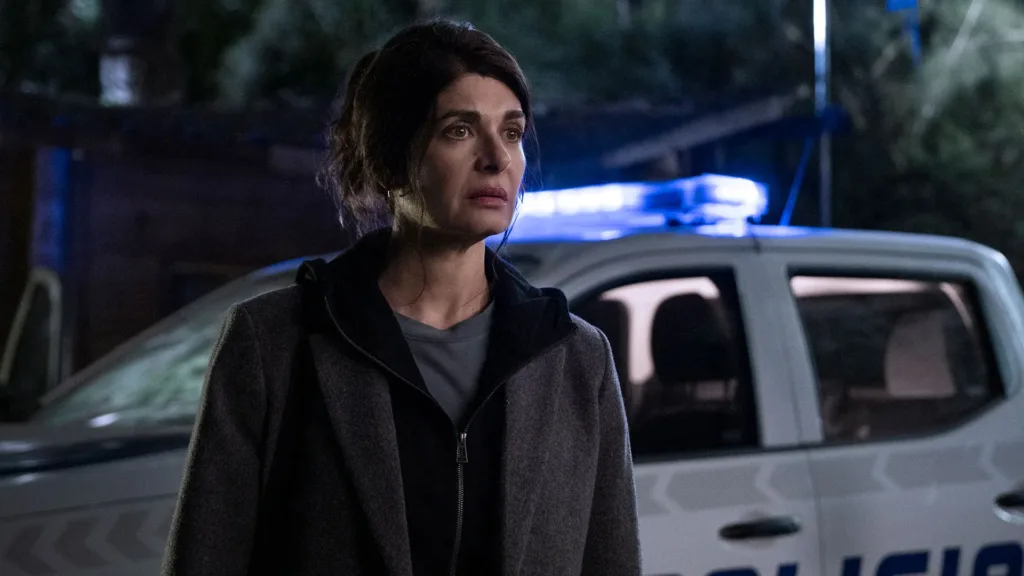Caught emerges as a television narrative born from a Harlan Coben novel, its existence marked by the stark embrace of Bariloche’s raw landscapes. In the rugged corners of Argentina, every frame is touched by the somber murmur of wind and water, a visual murmur that mirrors the unrest within its characters.
The series presents us with Ema Garay, a reporter burdened with the dual weight of protecting her child and seeking the truth hidden behind a troubling case. A story unfolds as a teenage girl vanishes amid unsettling circumstances, prompting an investigation into a murky world of grooming and concealed transgressions.
Bariloche itself serves as an austere canvas, its windswept expanses and isolated terrains reflecting the inner turmoil of those who wander its streets. The adaptation is as much about the investigation as it is about the human condition: a relentless questioning of duty, trust, and the nature of despair.
Here, every whispered secret and silent glance feels laden with existential gravity, inviting a reflection on the burdens we carry and the fragile light that persists in dark moments. Each element of the narrative is interlaced with an awareness of our own hidden sorrows, a quiet reminder of the inevitable clash between hope and the night.
Fragments of a Shattered Narrative
A mysterious call disrupts the quiet of an ordinary day, marking the onset of an investigation that unspools like a thread from a frayed garment. The narrative unfolds with deliberate shifts in time—a dance between what was and what now is—that unsettles the viewer.
Moments from the past flicker into the present, each flashback a spectral reminder of lost innocence and hidden guilt. This interplay of memory and immediacy invites a contemplation of time as a mutable force, where truth is as elusive as a shadow at dusk.
Ema, a reporter burdened by her own scars and the weight of a child’s absence, becomes the reluctant seeker of truth amid murky evidence. Her pursuit of a predator intersects with an enigma that spirals into the vanishing of a young life, forcing her to confront the fissures in her own existence.
As the investigation deepens, narrative threads converge in unpredictable turns. An ambiguous figure in the guise of Leo casts long silhouettes over the unfolding drama, his moral ambiguity stirring questions about the nature of trust and transgression.
The subplot that charts Ema’s struggles in balancing a solitary motherhood with her professional crusade adds another dimension to this multifaceted narrative. Her personal trials are interlaced with moments of fleeting connection and stark solitude, reflections of an inner battle that mirrors the external chaos. Secondary characters, each draped in their own secrets, contribute echoes of conflicting motives that complicate the central inquiry, urging us to ponder if certainty is ever within grasp.
This layered structure, with its intermingled past and present, builds a disquiet that permeates every scene. The shifting chronology creates a sense of disorientation—a labyrinthine path where every turn redefines what is known and what is feared. Each narrative choice invites the viewer to question the solidity of memory and the reliability of perception, leaving a residue of uncertainty that lingers long after the scene fades.
Contours of a Troubled Heart
Ema Garay stands at the center of a complex portrait of human struggle—a woman whose past seems etched into the lines of her face and whose every decision is marked by an unyielding quest for truth. Born from a life of hardship and the loss of what once mattered dearly, she wears her burdens with a quiet determination that borders on melancholy.
Balancing the ceaseless demands of investigative work with the delicate needs of motherhood, Ema’s journey reveals a soul caught between duty and the piercing weight of personal loss. Her search for hidden transgressions is as much an inward confrontation with her own vulnerabilities as it is a mission to expose the sinister elements that lurk in society.
In this shifting narrative, Leo Mercer emerges as a figure shrouded in uncertainty. Serving the community in a role meant to nurture, he nonetheless carries an air of suspicion—a dual presence that leaves his true intentions forever veiled. His subtle interplay with Ema introduces a tension that raises questions about trust and the nature of redemption.
Meanwhile, the fragile figure of Martina, with her spark of talent and underlying vulnerability, becomes a silent catalyst, a poignant reminder of the toll inflicted upon youth. The ripple effects of her fate underscore the stark reality of lost innocence in a world often indifferent to suffering.
Supporting characters like Bruno and the members of the investigative team contribute quieter notes to this somber symphony. Their interactions with Ema reveal moments of stark intimacy and conflict—a tapestry of fleeting warmth amid a pervasive chill, inviting us to reflect on the inherent costs of truth and the scars borne by those who dare to uncover it.
Shadows of a Digital Abyss
The series casts a stark light on the perils of a world ruled by digital interactions, where the virtual sphere transforms into a hunting ground for those seeking to prey on innocence. Ema’s investigation is a search not merely for proof but for understanding, as she peers into the murk of online grooming—a realm where anonymity masks dark intent.
Her journey through a network of hidden dangers questions the ethics of a society that readily exchanges privacy for connectivity, reflecting a modern malaise that haunts our collective digital existence.
Journalism in this narrative emerges as a double-edged sword. Ema’s relentless pursuit of truth underscores the responsibility carried by those who capture and broadcast reality, yet her work also exposes the lure of sensationalism. The show raises silent questions about the power of images and reports in molding perceptions, hinting at a culture where facts can be distorted into narratives that feed public fear.
Socioeconomic contrasts thread through the story, with stark differences in wealth and power underpinning the unfolding events. The tension between established social orders and the struggle for personal dignity echoes in the subtleties of land deals and resource control, painting a picture of a society divided by legacy and ambition.
In the midst of these conflicts, the vulnerability of youth is portrayed with an aching clarity, as figures like Martina become symbols of lost innocence amid societal pressures. This portrayal invites a reflection on how tradition and modernity collide, leaving scars on a generation grappling with the weight of unseen forces.
Echoes in the Frame
In the remote expanse of Bariloche, nature transforms into a silent witness. Rolling hills, shimmering lakes, and ancient forests become more than scenery; they are characters in their own right, mirroring the hidden turmoil of a troubled narrative. The camera captures sweeping vistas that seem to hold secrets, while intimate close-ups reveal faces etched with quiet despair. Each visual moment is a meditation on isolation and the ceaseless passage of time, reminding us that beauty and desolation often exist side by side.
The directors, working in unison yet with individual flair, orchestrate the pace with a mix of deliberate stillness and sudden urgency. Their technique of shuffling time—fragmented glimpses of memory interspersed with the present—creates a montage of life’s uncertainties, leaving the viewer to piece together fleeting impressions. Editing takes on a sculptural quality, carving out shards of moments that resonate with the viewer’s own unspoken questions.
Every element of production, from meticulously chosen costumes to the authenticity of local architecture, reinforces the Argentine essence of the series. The interplay of light and shadow on crafted sets echoes the inner conflict of characters, drawing attention to the silent power of their environments.
Sound design punctuates each scene; subtle audio cues and a measured score stir latent emotions, layering the narrative with an unyielding tension that permeates the experience. Lighting and acoustic balance merge to create an atmosphere where every visual and auditory detail seems to hold a mirror to the human condition.
Temporal Fractures and Lingering Dialogues
The script unfolds with a restless energy, charting a course through intricate twists that mirror the chaos of the human mind. The adaptation of the source material is marked by a willingness to disrupt a linear path, as flashbacks and abrupt shifts in time offer fragments of a truth that remains ever elusive.
Dialogue serves as both the vessel for character revelations and the driver of the plot’s forward motion, revealing layers of inner torment and ethical ambiguity. Moments of intense discovery oscillate with periods of quiet introspection, forming a rhythm that is as disjointed as it is deliberate.
This irregular cadence provokes the viewer to question if the sporadic glimpses into a character’s past are a key to understanding or a distraction from the present mystery. In blending the primary investigation with interlaced personal struggles and societal musings, the narrative risks scattering its focus, yet also invites reflection on the nature of accountability and regret.
The interplay between what is spoken and what is shown on screen creates a dynamic where visuals often whisper what dialogue cannot fully capture, leaving a lingering uncertainty in the wake of each carefully constructed scene.
Aftermath and Enduring Impressions
Caught offers a rich canvas painted with stark images of a fractured reality. Its setting, the raw expanse of Bariloche, merges seamlessly with a layered narrative where each twist and turn provokes the viewer to confront the darker facets of human existence.
The interplay between a troubled investigation and personal torment is rendered with a deliberate precision, inviting us to question the limits of truth in a world where digital dangers silently gnaw at innocence.
Ema Garay’s relentless quest for clarity amid moral ambiguity forms the emotional backbone of the series. Her encounters, whether with the enigmatic Leo Mercer or the fragile hope embodied in the fate of a young life, echo a somber meditation on trust and betrayal. The unfolding drama is marked by subtle contradictions—moments of raw exposure intermingled with pauses that leave the mind restless, pondering the nature of justice and the cost of vigilance.
Technical craft is woven into every frame, as the visual cadence and rhythmic editing underscore a tension that lingers like a half-remembered dream. The soundscape, gentle yet insistent, enriches these themes with quiet insistence, inviting the audience to dwell on the interplay between spectacle and the silent wounds of modern society.
The Review
Caught
Caught is a haunting exploration of modern fears and hidden truths. Its atmospheric visuals and disjointed narrative invite a meditation on digital dangers and moral uncertainty, even as the fragmented storytelling challenges viewer patience. The series offers a raw, reflective experience that questions the cost of exposing concealed realities.
PROS
- Striking visuals that evoke Bariloche’s rugged beauty
- Complex, layered narrative that challenges perceptions
- Strong performances that capture emotional depth
- Bold exploration of digital exploitation and moral dilemmas
- Innovative non-linear storytelling that provokes thought
CONS
- Fragmented narrative may disorient some viewers
- Inconsistent pacing at certain junctures
- Some character motivations remain ambiguous
- Thematic ambition occasionally impacts overall coherence





















































